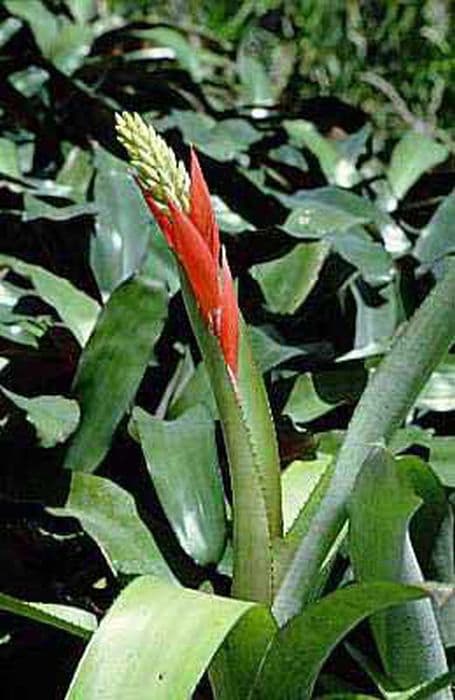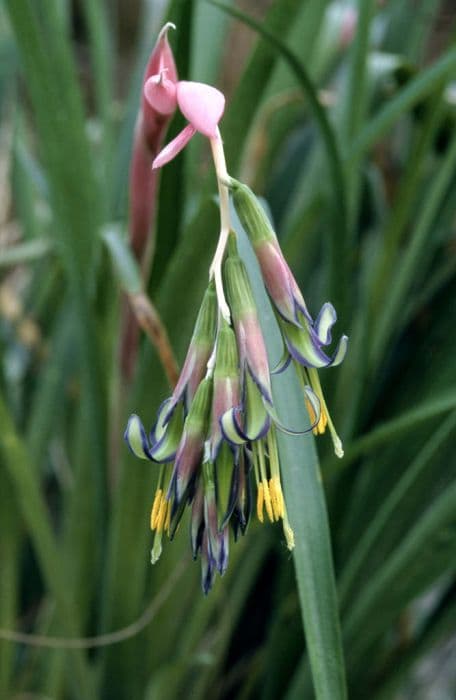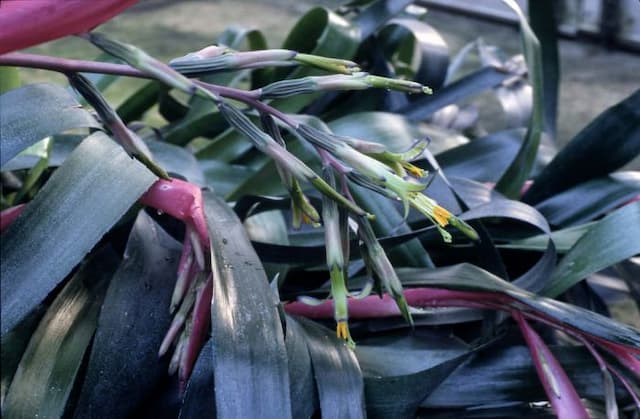Blue Fascicularia Fascicularia bicolor subsp. bicolor

ABOUT
The plant known commonly as hardy pineapple is a unique and striking specimen that features a rosette of narrow, spiky leaves. These leaves are primarily a deep green color, often accentuated with silver-gray bands that run the length of each leaf, giving it a textured and variegated appearance. As the name suggests, there is a resemblance to pineapple plants, though this plant is not known for producing the familiar fruit. In the center of the rosette, the foliage can turn a bright, vivid red, providing a stunning contrast to the green leaves. This change in color often occurs when the plant is preparing to flower. The flowers themselves are small and blue, which appear in the center of the rosette nestled within the red leaves, looking almost like a colorful jewel within the bright framework. The overall look of the hardy pineapple is quite architectural and rigid due to its stiff leaves, making it a favored choice for adding a touch of the exotic to gardens or as part of a rockery. It’s also popular for its drought-resistant qualities, as the spiky leaves are efficient at conserving water. Despite its tropical name and appearance, the plant is noted for its hardiness and is able to withstand cooler temperatures, which is partly why it is given the moniker "hardy" pineapple.
About this plant
 Names
NamesFamily
Bromeliaceae
Synonyms
Chilean Wheel Plant, Blue Fascicularia
Common names
Fascicularia bicolor, Fascicularia bicolor var. bicolor, Fascicularia bicolor subsp. canaliculata, Fascicularia canaliculata, Fascicularia denticulata, Fascicularia kirchhoffiana.
 Toxicity
ToxicityTo humans
Fascicularia bicolor, commonly known as Hardy Bromeliad, is not known to be toxic to humans. Therefore, ingestion of parts of this plant typically does not result in poisoning or adverse symptoms.
To pets
Hardy Bromeliad is not known to be toxic to pets. It is not commonly reported to cause poisoning or adverse symptoms if pets ingest parts of this plant.
 Characteristics
CharacteristicsLife cycle
Perennials
Foliage type
Evergreen
Color of leaves
Green
Flower color
Blue
Height
1 foot (0.3 meters)
Spread
2 feet (0.6 meters)
Plant type
Bromeliad
Hardiness zones
9
Native area
Chile
Benefits
 General Benefits
General Benefits- Ornamental Value: Fascicularia bicolor provides striking visual appeal with its rosettes of silvery-green leaves and vibrant red center when in bloom.
- Drought Tolerant: It is highly tolerant of dry conditions once established, making it a suitable choice for water-wise gardens or xeriscaping.
- Low Maintenance: It requires minimal upkeep beyond the occasional removal of dead leaves, making it an excellent option for low-maintenance landscapes.
- Cold Hardy: Able to withstand cooler temperatures than many other bromeliads, it can be grown in a range of climates.
- Wildlife Attraction: Attracts pollinators such as bees when in flower, contributing to the health of the local ecosystem.
- Architectural Plants: Its unique shape and form add an architectural element to garden designs, which can be particularly striking in modern landscaping schemes.
- Ground Cover: Its growth habit makes it useful for ground cover, reducing weed growth and soil erosion in gardens.
- Container Planting: Adaptability to pot culture allows it to be featured on patios, terraces, or indoor spaces for a splash of color.
- Companion Planting: Can be combined with other drought-tolerant plants to create an interesting and sustainable garden composition.
 Medical Properties
Medical PropertiesThis plant is not used for medical purposes.
 Air-purifying Qualities
Air-purifying QualitiesThis plant is not specifically known for air purifying qualities.
 Other Uses
Other Uses- Ornamental Display: The Fascicularia bicolor, commonly known as Fascicularia, can be used for ornamental purposes in rockeries and alpine gardens, thanks to its striking red center and blue-green leaves.
- Container Gardening: Fascicularia makes an excellent choice for container displays, adding an exotic touch to patios, balconies, and other outdoor living spaces.
- Edible Uses: In some cultures, the fruits of Fascicularia are occasionally eaten, although this is not a widespread practice.
- Textile Dye: The vivid red color from the bracts of the Fascicularia can be used as a natural dye for textiles, providing an eco-friendly coloring option.
- Living Wall Accents: Fascicularia can be planted in green or living walls, where it can serve as an eye-catching feature due to its rosette form and colorful center.
- Garden Borders: Due to its compact size, Fascicularia can be utilized effectively as a border plant in garden bed designs.
- Floral Arrangements: The rosettes and sometimes flowers of Fascicularia are occasionally used to add a tropical flair to cut flower arrangements.
- Photography Prop: The unique appearance of Fascicularia is often sought after by photographers looking for exotic and colorful plant subjects.
- Xeriscaping: Fascicularia is suitable for xeriscaped gardens, as it is drought-tolerant once established, reducing the need for frequent watering.
- Education and Research: Fascicularia is sometimes used in botany and horticulture education and research to learn more about bromeliad care and propagation techniques.
Interesting Facts
 Feng Shui
Feng ShuiThe Fascicularia bicolor is not used in Feng Shui practice.
 Zodiac Sign Compitability
Zodiac Sign CompitabilityThe Fascicularia bicolor is not used in astrology practice.
 Plant Symbolism
Plant Symbolism- Resilience: Fascicularia bicolor subsp. bicolor, commonly known as hardy pineapple, is a tough plant that thrives in adverse conditions. Its ability to withstand challenges makes it symbolic of resilience.
- Uniqueness: The hardy pineapple's distinctive appearance, with its bright red center and sharp leaves, can be seen as a celebration of uniqueness and standing out from the crowd.
- Adaptability: This plant has the ability to adapt to various environments and is often grown in different conditions, which turns it into a symbol of adaptability and flexibility.
- Welcoming: Although it is not a true pineapple, the hardy pineapple may still carry the traditional pineapple symbol of hospitality and welcoming due to its resemblance to the pineapple plant.
- Exotic beauty: With its striking colors and exotic looks, the hardy pineapple represents exotic beauty and allure, often catching the eye in gardens and displays.
 Water
WaterFor the Chilean hardy pineapple, it is crucial to maintain a consistent watering routine. During the growing season, water it thoroughly once a week, ensuring that the soil is moist but not waterlogged. Provide about 16-32 ounces of water each time, based on the size and condition of the plant. Reduce watering during the winter months, allowing the soil to dry out slightly between waterings. Overwatering can lead to root rot, so it's essential to have good drainage.
 Light
LightThe Chilean hardy pineapple flourishes best in bright indirect light conditions. It should be positioned in a spot where it can receive filtered sunlight, such as behind a sheer curtain near an east or west-facing window. Directly exposing the plant to harsh direct sunlight, especially during the heat of the day, can cause the leaves to scorch.
 Temperature
TemperatureThe Chilean hardy pineapple plant prefers temperatures between 60°F and 75°F for optimal growth. It can tolerate a minimum temperature of around 40°F but should be protected from frost. In regions where temperatures drop below this point, it is best to grow the plant in a container that can be moved to a sheltered location.
 Pruning
PruningPruning the Chilean hardy pineapple is mainly done to remove dead or damaged leaves and to maintain its shape. Prune sparingly, only as needed, typically once a year in early spring. Utilize clean, sharp pruning shears to make precise cuts and avoid tearing the leaves, which could make the plant vulnerable to diseases.
 Cleaning
CleaningAs needed
 Soil
SoilThe best soil mix for Hardy Pineapple (Fascicularia bicolor subsp. bicolor) is a well-draining, sandy or gritty compost as they prefer similar conditions to succulents. Add some organic matter to retain slight moisture. Aim for a soil pH around 5.5 to 7.5, which accommodates its preference for slightly acidic to neutral soil.
 Repotting
RepottingHardy Pineapple should be repotted every 2 to 3 years, or when the plant outgrows its pot. The best time to repot is during the spring or early summer months when the plant is actively growing.
 Humidity & Misting
Humidity & MistingThe Hardy Pineapple prefers moderate humidity levels but is fairly adaptable. Aim to maintain humidity around 60% for optimal growth, but it can tolerate lower humidity levels without significant harm.
 Suitable locations
Suitable locationsIndoor
Place Hardy Pineapple in bright, indirect light indoors with some direct sun.
Outdoor
Plant Hardy Pineapple in a sunny spot with well-draining soil.
Hardiness zone
9-11 USDA.
 Life cycle
Life cycleFascicularia bicolor subsp. bicolor, commonly known as Hardy Fascicularia, begins its life cycle with seed germination, which occurs in moist, well-draining soil, typically in mild to warm climates. After sprouting, the seedling develops into a rosette-forming perennial that grows slowly, producing strappy leaves that form a dense cluster. The plant matures over several years and reaches flowering maturity, where it develops a striking central inflorescence with bright blue and red flowers that attract pollinators such as bees and birds. Once pollinated, the flowers produce berry-like fruits containing seeds, which can be dispersed by animals or fall to the ground to potentially germinate new plants. After flowering, the individual rosette that has flowered usually dies, but because the plant often produces offsets or 'pups', these continue to grow and eventually repeat the flowering cycle. The life span of each rosette can vary but typically spans several years before the cycle is repeated through its offsets.
 Propogation
PropogationPropogation time
Spring-Early Summer
The Chilean Hardy Bromeliad, scientifically known as Fascicularia bicolor subsp. bicolor, can generally be propagated by offsets, which are the small plants that form at the base of the mother plant. The best time for propagation is late spring or early summer, when these offsets are produced and have grown to a reasonable size, which is typically a few inches in diameter. To propagate the Chilean Hardy Bromeliad using offsets, carefully remove the offsets from the mother plant, ensuring each has some roots attached. Plant the offsets in a well-draining soil mix, ideally one tailored for bromeliads or succulents, and water them sparingly to avoid rot. In the right conditions, the offsets should establish themselves and start to grow independently within a few weeks, forming their own roots and foliage as they mature into new plants.









